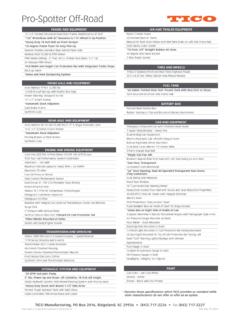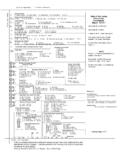Transcription of Lion Oil Company
1 Lion Oil Company Product: off road Diesel Fuel Revision No. 7 MSDS No. LO0308 Date of Preparation: 06-11-13 Section 1 - Chemical Product and Company Identification Product/Chemical Name: off road Diesel Fuel CAS Number: 68476-34-6 Synonyms: Red Dyed Ultra Low Sulfur Diesel, #2 Diesel, Diesel Fuel, #2 Fuel Oil, High Sulfur Diesel, Red Dyed Diesel, Red Dyed Low Sulfur Diesel, Red Dyed B5 Ultra Low Sulfur Diesel Description: Red color with distinct hydrocarbon odor Manufacturer or Distributor: Lion Oil Co., 1000 McHenry St., El Dorado, AR 71730; (870) 862-8111 24-hr Emergency Phone Number: FOR CHEMICAL EMERGENCY Spill, Leak, Fire, Exposure or Accident CALL CHEMTREC Day or Night 800-424-9300 MSDS CONTACT: Beverly McFarland 870-864-1306 Section 2 - Hazards Identification Emergency Overview Health Warning!
2 Fammability Combustible liquid moderate fire hazard. Physical Haz. May cause moderate eye and skin irritation. Long term, prolonged or repeated skin contact may increase the risk of skin cancer. Harmful or fatal if swallowed can enter lungs and cause damage. May be harmful if absorbed through skin. Potential Health Effects Primary Entry Routes: Skin and/or Eye contact, Ingestion, Inhalation, Target Organs: Skin, Eyes, Central Nervous System Carcinogenicity: IARC has classified diesel fuel as a group 2B carcinogen, sufficient evidence in animals, possibly carcinogenic to humans. Prolonged or repeated contact with this material can cause cancer. Contains Polynuclear aromatics, which has been designated as a carcinogen by IARC (group 1).
3 Risk of cancer depends on duration and level of exposure. IARC has classified diesel engine exhaust as a group 2A carcinogen, sufficient evidence in animals, probably carcinogenic to humans. Acute Effects Eye: May cause irritation of the eye. Skin: Excessive skin contact may cause irritation and dermatitis. Inhalation: Irritation, dizziness, headaches, and nausea. Excessive breathing may cause central nervous system effects. Ingestion: Do Not Induce Vomiting. Causes nausea, vomiting, and cramping; depression of central nervous system ranging from mild headache to anesthesia, coma, and death; pulmonary irritation secondary to exhalation of solvent; signs of kidney and liver damage may be delayed. Aspiration into lungs, c auses severe lung irritation with coughing, gagging, dyspnea, substernal distress, and rapidly developing pulmonary edema; later, signs of bronchopneumonia and pneumonitis; acute onset of central nervous system excitement followed by depression.
4 Chronic Effects Prolonged or repeated contact with this material can cause cancer. IARC has classified diesel fuel as a group 2B carcinogen, sufficient evidence in animals, possibly carcinogenic to humans. Contains Polynuclear aromatics, which has been designated as a carcinogen by IARC (group 1). Risk of cancer depends on duration and level of exposure. Section Ref. (3, 10) HMIS H F PH 1* 2 0 PPE Sec. 8 06-11-13 MSDS No. LO0308 off road Diesel Fuel Page 2 of 8 GHS CLASSIFICATION Hazard class Hazard Category Hazard Statement Combustible Liquid Category 4 H227 Aspiration hazard Category 1 H304 Carcinogenicity Category 2 H350 Acute toxicity, inhalation Category 4 H332 Specific target organ toxicity (Blood, Liver, Thymus, repeated exposure) Category 2 H373 Skin, corrosion/irritation Category 2 H315 Chronic hazards to the aquatic environment Category 2 H411 LABEL ELEMENTS Pictogram: Signal Word: Danger Physical Hazard Statements: H227 Combustible liquid; will ignite on surface at temperatures above auto-ignition temp.
5 Health Hazard Statements: H304 May be fatal if swallowed and enters airways. H350 May cause cancer. H332 Harmful if inhaled. H373 May cause damage to organs through prolonged or repeated exposure. H315 Causes skin irritation. Environmental Hazard Statements: H411 Toxic to aquatic life with long lasting effects. Precautionary Statements: Prevention: P280: Wear protective gloves/protective clothing/eye protection/face protection P260 Do not breathe dust/fume/ gas/ mist/vapors/ spray. Response: P301 + P310 IF SWALLOWED: Immediately call a POISON CENTER or doctor/ physician. P331 Do NOT induce vomiting. Disposal: P501 Dispose of contents/containers to an approved waste management Company or reclaimer. Unclassified hazards: Vapors in the headspace of tanks and containers may ignite and explode at temperatures exceeding auto-ignition temperature where vapor concentrations are within the flammability range.
6 Electrostatic charges may be generated during pumping. Electrostatic discharge may cause fire. Section 3 - Composition / Information on Ingredients Ingredient Name CAS Number %wt. Diesel Fuel, A distillate oil having a minimum viscosity of SUS at ( ) to a maximum of SUS at ( ) 68476-34-6 95-100 B100 Biodiesel: (68937-84-8) Fatty Acid Methyl Ester, FAME (67784-80-9) Soybean derived (61788-61-2) Tallow derived (129828-16-6) Canola derived (73891-99-3) Rapeseed derived mixture < Naphthalene 91-20-3 Xylenes 1330-20-7 < 06-11-13 MSDS No. LO0308 off road Diesel Fuel Page 3 of 8 Section 4 - First Aid Measures Eye Contact: Flush with water for at least 20 minutes.
7 Seek medical attention. Skin Contact: Remove any contaminated clothing and w ash with soap and water at least 20 minutes. Launder or dry-clean clothing before reuse. Inhalation: Move to fresh air. If breathing is irregular or has stopped, start resuscitation, and then administer oxygen if available. Seek medical attention. Ingestion: Do not induce vomiting. Vomiting may cause aspiration into lungs. If spontaneous vomiting is about to occur, place victim s head below knees. Seek medical attention. After first aid, get appropriate in-plant, paramedic, or community medical support. Section Ref. (4) Section 5 - Fire-Fighting Measures Flash Point: >140 F Flash Point Method: PM Autoignition Temperature: 500 F LEL: UEL: Emergency Response Guide: Guide No. 128 Flammability Classification: Combustible liquid Extinguishing Media: Extinguish with dry chemical, CO2, foam and water fog.
8 Solid streams of water may be ineffective. Cool affected containers and vessels with flooding quantities of water. Apply water from as great a distance as possible. Keep run off water out of sewers and water sources. Minimize breathing of gases, vapor, fumes, or decomposition products. Use self-contained breathing apparatus for enclosed or confined spaces or as otherwise needed. Unusual Fire or Explosion Hazards: Do not store near strong oxidants or open flame. Hazardous Combustion Products: Under fire conditions May form toxic materials; carbon dioxide and monoxide, oxides of sulfur and H2S, and other decomposition products, in the case of incomplete combustion. Fire-Fighting Instructions: Extinguish with dry chemical, CO2, foam and water fog. Solid streams of water may be ineffective. Cool affected containers and vessels with flooding quantities of water.
9 Apply water from as great a distance as possible. Keep run off water out of sewers and water sources. Minimize breathing of gases, vapor, fumes, or decomposition products. Special Fire-Fighting Procedures: Use self-contained breathing apparatus for enclosed or confined spaces or as otherwise needed. Cool exposed containers and vessels with water. Section Ref. (4, 9, 10) Section 6 - Accidental Release Measures FOR CHEMICAL EMERGENCY Spill, Leak, Fire, Exposure or Accident CALL CHEMTREC Day or Night 800-424-9300 Spill /Leak Procedures: Shut off sources of ignition. Shut off leak, if possible without risk. Take up with sand or other non-combustible, absorbent material. Small Spills: Take up with an absorbent material and place in containers, seal tightly for proper disposal. Large Spills: Isolate the hazard area and restrict entry to unnecessary personnel.
10 Shut off source of leak only if it can be done so safely or dike and contain the spill. Keep run off out of sewers and water sources. Wear appropriate respirator and protective clothing. If possible remove product with vacuum trucks. Soak up residue with sand or other suitable material, place in containers for proper disposal. Local, state and federal disposal regulations must be followed. Regulatory Requirements: Report any spills that could reach any surface waters to the Coast Guard National Response Center (800) 424-8802. Section Ref. (4) Section 7 - Handling and Storage Handling Precautions: Do not handle or store near heat, sparks, or flame. Storage Requirements: Do not store near strong oxidants or open flames.






